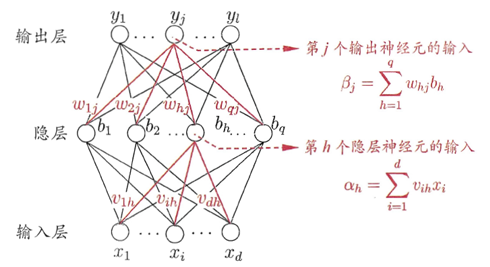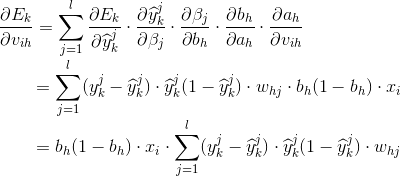您好,登錄后才能下訂單哦!
您好,登錄后才能下訂單哦!
1.簡單介紹
在機器學習和認知科學領域,人工神經網絡(artificial neural network,縮寫ANN),簡稱神經網絡(neural network,縮寫NN)或類神經網絡,是一種模仿生物神經網絡(動物的中樞神經系統,特別是大腦)的結構和功能的數學模型或計算模型,用于對函數進行估計或近似。神經網絡由大量的人工神經元聯結進行計算。大多數情況下人工神經網絡能在外界信息的基礎上改變內部結構,是一種自適應系統。現代神經網絡是一種非線性統計性數據建模工具。典型的神經網絡具有以下三個部分:
結構 (Architecture) 結構指定了網絡中的變量和它們的拓撲關系。例如,神經網絡中的變量可以是神經元連接的權重(weights)和神經元的激勵值(activities of the neurons)。
激勵函數(Activity Rule) 大部分神經網絡模型具有一個短時間尺度的動力學規則,來定義神經元如何根據其他神經元的活動來改變自己的激勵值。一般激勵函數依賴于網絡中的權重(即該網絡的參數)。
學習規則(Learning Rule)學習規則指定了網絡中的權重如何隨著時間推進而調整。這一般被看做是一種長時間尺度的動力學規則。一般情況下,學習規則依賴于神經元的激勵值。它也可能依賴于監督者提供的目標值和當前權重的值。
2.初識神經網絡
如上文所說,神經網絡主要包括三個部分:結構、激勵函數、學習規則。圖1是一個三層的神經網絡,輸入層有d個節點,隱層有q個節點,輸出層有l個節點。除了輸入層,每一層的節點都包含一個非線性變換。

圖1
那么為什么要進行非線性變換呢?
(1)如果只進行線性變換,那么即使是多層的神經網絡,依然只有一層的效果。類似于0.6*(0.2x1+0.3x2)=0.12x1+0.18x2。
(2)進行非線性變化,可以使得神經網絡可以擬合任意一個函數,圖2是一個四層網絡的圖。

圖2
下面使用數學公式描述每一個神經元工作的方式
(1)輸出x
(2)計算z=w*x
(3)輸出new_x = f(z),這里的f是一個函數,可以是sigmoid、tanh、relu等,f就是上文所說到的激勵函數。
3.反向傳播(bp)算法
有了上面的網絡結構和激勵函數之后,這個網絡是如何學習參數(學習規則)的呢?
首先我們先定義下本文使用的激活函數、目標函數
(1)激活函數(sigmoid):
def sigmoid(z): return 1.0/(1.0+np.exp(-z))
sigmoid函數有一個十分重要的性質: ,即計算導數十分方便。
,即計算導數十分方便。
def sigmoid_prime(z): return sigmoid(z)*(1-sigmoid(z))
下面給出一個簡單的證明:
(2)目標函數(差的平方和) ,公式中的1/2是為了計算導數方便。
,公式中的1/2是為了計算導數方便。
然后,這個網絡是如何運作的
(1)數據從輸入層到輸出層,經過各種非線性變換的過程即前向傳播。
def feedforward(self, a):
for b, w in zip(self.biases, self.weights):
a = sigmoid(np.dot(w, a)+b)
return a
其中,初始的權重(w)和偏置(b)是隨機賦值的
biases = [np.random.randn(y, 1) for y in sizes[1:]] weights = [np.random.randn(y, x) for x, y in zip(sizes[:-1], sizes[1:])]
(2)參數更新,即反向傳播
在寫代碼之前,先進行推導,即利用梯度下降更新參數,以上面的網絡結構(圖1)為例
(1)輸出層與隱層之間的參數更新

(2)隱層與輸入層之間的參數更新

有兩點需要強調下:
(2)中的結果比(1)中的結果多了一個求和公式,這是因為計算隱層與輸入層之間的參數時,輸出層與隱層的每一個節點都有影響。
(2)中參數更新的結果可以復用(1)中的參數更新結果,從某種程度上,與反向傳播這個算法名稱不謀而合,不得不驚嘆。
def backprop(self, x, y):
"""返回一個元組(nabla_b, nabla_w)代表目標函數的梯度."""
nabla_b = [np.zeros(b.shape) for b in self.biases]
nabla_w = [np.zeros(w.shape) for w in self.weights]
# feedforward
activation = x
activations = [x] # list to store all the activations, layer by layer
zs = [] # list to store all the z vectors, layer by layer
for b, w in zip(self.biases, self.weights):
z = np.dot(w, activation)+b
zs.append(z)
activation = sigmoid(z)
activations.append(activation)
# backward pass
delta = self.cost_derivative(activations[-1], y) * \
sigmoid_prime(zs[-1])
nabla_b[-1] = delta
nabla_w[-1] = np.dot(delta, activations[-2].transpose())
"""l = 1 表示最后一層神經元,l = 2 是倒數第二層神經元, 依此類推."""
for l in xrange(2, self.num_layers):
z = zs[-l]
sp = sigmoid_prime(z)
delta = np.dot(self.weights[-l+1].transpose(), delta) * sp
nabla_b[-l] = delta
nabla_w[-l] = np.dot(delta, activations[-l-1].transpose())
return (nabla_b, nabla_w)
4.完整代碼實現
# -*- coding: utf-8 -*-
import random
import numpy as np
class Network(object):
def __init__(self, sizes):
"""參數sizes表示每一層神經元的個數,如[2,3,1],表示第一層有2個神經元,第二層有3個神經元,第三層有1個神經元."""
self.num_layers = len(sizes)
self.sizes = sizes
self.biases = [np.random.randn(y, 1) for y in sizes[1:]]
self.weights = [np.random.randn(y, x)
for x, y in zip(sizes[:-1], sizes[1:])]
def feedforward(self, a):
"""前向傳播"""
for b, w in zip(self.biases, self.weights):
a = sigmoid(np.dot(w, a)+b)
return a
def SGD(self, training_data, epochs, mini_batch_size, eta,
test_data=None):
"""隨機梯度下降"""
if test_data:
n_test = len(test_data)
n = len(training_data)
for j in xrange(epochs):
random.shuffle(training_data)
mini_batches = [
training_data[k:k+mini_batch_size]
for k in xrange(0, n, mini_batch_size)]
for mini_batch in mini_batches:
self.update_mini_batch(mini_batch, eta)
if test_data:
print "Epoch {0}: {1} / {2}".format(j, self.evaluate(test_data), n_test)
else:
print "Epoch {0} complete".format(j)
def update_mini_batch(self, mini_batch, eta):
"""使用后向傳播算法進行參數更新.mini_batch是一個元組(x, y)的列表、eta是學習速率"""
nabla_b = [np.zeros(b.shape) for b in self.biases]
nabla_w = [np.zeros(w.shape) for w in self.weights]
for x, y in mini_batch:
delta_nabla_b, delta_nabla_w = self.backprop(x, y)
nabla_b = [nb+dnb for nb, dnb in zip(nabla_b, delta_nabla_b)]
nabla_w = [nw+dnw for nw, dnw in zip(nabla_w, delta_nabla_w)]
self.weights = [w-(eta/len(mini_batch))*nw
for w, nw in zip(self.weights, nabla_w)]
self.biases = [b-(eta/len(mini_batch))*nb
for b, nb in zip(self.biases, nabla_b)]
def backprop(self, x, y):
"""返回一個元組(nabla_b, nabla_w)代表目標函數的梯度."""
nabla_b = [np.zeros(b.shape) for b in self.biases]
nabla_w = [np.zeros(w.shape) for w in self.weights]
# 前向傳播
activation = x
activations = [x] # list to store all the activations, layer by layer
zs = [] # list to store all the z vectors, layer by layer
for b, w in zip(self.biases, self.weights):
z = np.dot(w, activation)+b
zs.append(z)
activation = sigmoid(z)
activations.append(activation)
# backward pass
delta = self.cost_derivative(activations[-1], y) * sigmoid_prime(zs[-1])
nabla_b[-1] = delta
nabla_w[-1] = np.dot(delta, activations[-2].transpose())
"""l = 1 表示最后一層神經元,l = 2 是倒數第二層神經元, 依此類推."""
for l in xrange(2, self.num_layers):
z = zs[-l]
sp = sigmoid_prime(z)
delta = np.dot(self.weights[-l+1].transpose(), delta) * sp
nabla_b[-l] = delta
nabla_w[-l] = np.dot(delta, activations[-l-1].transpose())
return (nabla_b, nabla_w)
def evaluate(self, test_data):
"""返回分類正確的個數"""
test_results = [(np.argmax(self.feedforward(x)), y) for (x, y) in test_data]
return sum(int(x == y) for (x, y) in test_results)
def cost_derivative(self, output_activations, y):
return (output_activations-y)
def sigmoid(z):
return 1.0/(1.0+np.exp(-z))
def sigmoid_prime(z):
"""sigmoid函數的導數"""
return sigmoid(z)*(1-sigmoid(z))
5.簡單應用
# -*- coding: utf-8 -*-
from network import *
def vectorized_result(j,nclass):
"""離散數據進行one-hot"""
e = np.zeros((nclass, 1))
e[j] = 1.0
return e
def get_format_data(X,y,isTest):
ndim = X.shape[1]
nclass = len(np.unique(y))
inputs = [np.reshape(x, (ndim, 1)) for x in X]
if not isTest:
results = [vectorized_result(y,nclass) for y in y]
else:
results = y
data = zip(inputs, results)
return data
#隨機生成數據
from sklearn.datasets import *
np.random.seed(0)
X, y = make_moons(200, noise=0.20)
ndim = X.shape[1]
nclass = len(np.unique(y))
#劃分訓練、測試集
from sklearn.cross_validation import train_test_split
train_x,test_x,train_y,test_y = train_test_split(X,y,test_size=0.2,random_state=0)
training_data = get_format_data(train_x,train_y,False)
test_data = get_format_data(test_x,test_y,True)
net = Network(sizes=[ndim,10,nclass])
net.SGD(training_data=training_data,epochs=5,mini_batch_size=10,eta=0.1,test_data=test_data)
參考文獻
(1)周志華《機器學習》
(2)https://github.com/mnielsen/neural-networks-and-deep-learning
(3)https://zhuanlan.zhihu.com/p/21525237
以上就是本文的全部內容,希望對大家的學習有所幫助,也希望大家多多支持億速云。
免責聲明:本站發布的內容(圖片、視頻和文字)以原創、轉載和分享為主,文章觀點不代表本網站立場,如果涉及侵權請聯系站長郵箱:is@yisu.com進行舉報,并提供相關證據,一經查實,將立刻刪除涉嫌侵權內容。